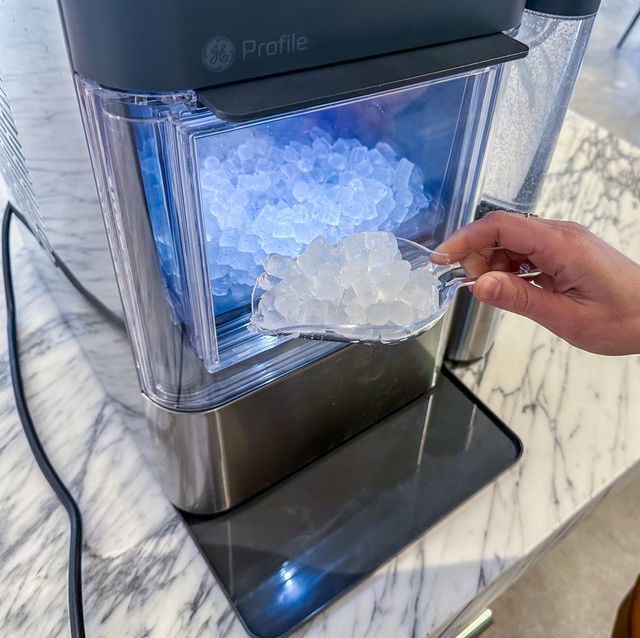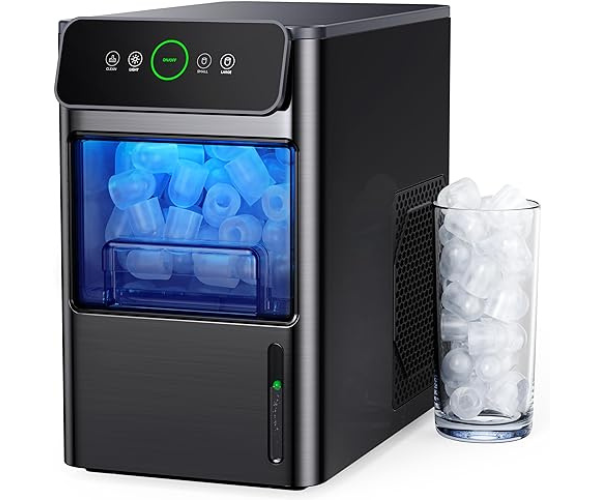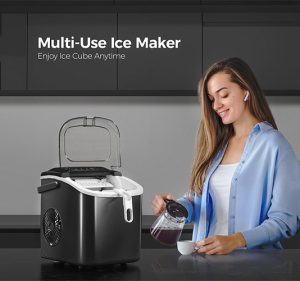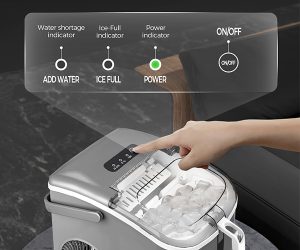Introduction
Countertop ice makers have rapidly become an essential appliance for many households, offering convenience, portability, and the ability to produce fresh ice on demand. Whether you’re hosting a party, enjoying a chilled drink, or simply want to keep your beverages cold, a countertop ice maker can be a valuable addition to your kitchen. But when it comes to choosing the right model, one of the most common questions arises: Do countertop ice makers need a water line?
Understanding the water requirements of a countertop ice maker is crucial for making an informed purchase. Some people might assume that all ice makers need to be connected to a water line, similar to larger, built-in models. However, the reality is more nuanced, and understanding the difference can save you time, money, and potential frustration.
In this comprehensive guide, we’ll explore everything you need to know about countertop ice makers, including whether they require a water line, how they work, and the best models available on the market today. We’ll also provide a detailed buying guide to help you choose the perfect ice maker for your needs, and offer tips on maintaining and using your appliance effectively.
Whether you’re new to countertop ice makers or looking to upgrade your current model, this guide will provide all the information you need to make the best choice for your home. Let’s dive in!
How Do Countertop Ice Makers Work?
Basic Functionality of Countertop Ice Makers
To understand whether a countertop ice maker requires a water line, it’s essential to first grasp how these appliances work. Countertop ice makers are designed to be compact and efficient, producing ice quickly and easily without taking up much space. Unlike traditional ice makers, which are often built into refrigerators or connected to a home’s plumbing system, countertop ice makers are standalone units.https://amzn.to/4cwk6tP

At the core of a countertop ice maker’s operation is its water reservoir. Instead of drawing water from a dedicated line, the user manually fills the reservoir with water. Once filled, the ice maker draws the water into a freezing chamber, where it is cooled by a refrigeration unit. The ice is then formed into small cubes, nuggets, or other shapes, depending on the model, and deposited into a storage bin, ready for use.
Water Source Requirements
One of the key features of countertop ice makers is their independence from a fixed water line. This means that you don’t need to worry about connecting the unit to your home’s plumbing, which can be a significant advantage for many users. Instead, you simply fill the machine’s water reservoir manually. This design makes countertop ice makers incredibly versatile, allowing them to be used in a variety of settings, from kitchens to offices to outdoor events.
The ability to use a countertop ice maker without a water line also contributes to its portability. Since you’re not tethered to a specific location with a water connection, you can easily move the ice maker wherever it’s needed. Whether you’re hosting a backyard barbecue or setting up a temporary bar in your living room, a countertop ice maker can go wherever the party is.
In summary, the fundamental design of a countertop ice maker eliminates the need for a water line, making it a convenient and flexible choice for many households. However, this convenience comes with certain considerations, particularly when it comes to manual water filling, which we’ll explore in more detail in the following sections.
Do Countertop Ice Makers Require a Water Line?
General Overview
A common question among potential buyers is whether countertop ice makers require a water line. The straightforward answer is no—most countertop ice makers do not need a water line. This is one of the primary features that differentiate them from larger, built-in ice makers that are often integrated into a refrigerator or a commercial kitchen setup.
Countertop ice makers are designed to operate independently, relying on a manually filled water reservoir rather than a continuous water supply. This design offers significant advantages, including ease of installation and flexibility in placement. Without the need for plumbing or professional installation, users can simply plug in the ice maker, fill it with water, and start producing ice within minutes.
Advantages of Not Needing a Water Line
The absence of a water line requirement provides several benefits:
- Flexibility in Placement: Without the need for a fixed water connection, you can place your countertop ice maker wherever it’s most convenient. This could be on your kitchen counter, a home bar, or even an outdoor patio during a party. The freedom to move the ice maker as needed makes it a versatile appliance for various settings.
- Ease of Use and Setup: Setting up a countertop ice maker is as simple as plugging it in and filling the water reservoir. There’s no need to hire a plumber or worry about connecting to existing plumbing, which can save time and money. This simplicity is particularly appealing to those who want a hassle-free experience.
- Portability: The portable nature of countertop ice makers is a significant advantage, especially for those who like to entertain in different locations. Whether you’re camping, tailgating, or just moving the ice maker from the kitchen to the living room, the lack of a water line means you can take your ice maker with you wherever you go.
Models That May Have Water Line Options
While the majority of countertop ice makers do not require a water line, there are some exceptions. A few high-end models or those designed for more demanding use cases may offer the option to connect to a water line. These models are often larger and more expensive, catering to users who need a constant supply of ice without the need for manual refilling.
For example, some countertop ice makers designed for commercial use or large households might include a water line connection as an optional feature. This allows for continuous ice production without the need to constantly monitor and refill the water reservoir. However, it’s important to note that these models are less common and typically fall into a higher price range.
In summary, while most countertop ice makers do not require a water line, there are a few models that offer this feature for those who need it. For the average user, however, a standard countertop ice maker without a water line is likely to be the most practical and convenient option.
Manual Water Filling: What You Need to Know
How to Fill a Countertop Ice Maker with Water
One of the key tasks when using a countertop ice maker is manually filling the water reservoir. This process is straightforward but requires some attention to detail to ensure optimal ice production. Here’s a step-by-step guide on how to fill your countertop ice maker with water:
- Locate the Water Reservoir: Most countertop ice makers have a clearly marked reservoir, usually located at the top or back of the unit. Open the lid or access panel to expose the reservoir.
- Check the Water Level Indicator: Many models come with a water level indicator, showing the minimum and maximum fill levels. It’s important to stay within these limits to avoid overfilling or underfilling the reservoir, which could affect ice production.
- Fill with Water: Using a pitcher or jug, carefully pour water into the reservoir. It’s best to use clean, cold water. If you’re using tap water, consider using a filter to remove any impurities that might affect the taste of the ice or cause mineral buildup in the machine.
- Close the Reservoir: Once the reservoir is filled to the appropriate level, close the lid or access panel securely to prevent spills.
- Start the Ice Maker: After filling the reservoir, turn on the ice maker according to the manufacturer’s instructions. The machine will begin drawing water into the freezing chamber, and you should have fresh ice within minutes.
How Often Do You Need to Refill the Water?
The frequency with which you’ll need to refill the water reservoir depends on several factors, including the size of the reservoir, the ice production rate, and your ice usage. On average, most countertop ice makers produce a batch of ice every 6 to 15 minutes, depending on the model. This means that in high-demand situations, you might need to refill the reservoir every few hours.
To give a general idea, a standard countertop ice maker with a 2 to 3-liter reservoir can produce around 24 pounds of ice in 24 hours. If you’re hosting a party or using the ice maker continuously, you’ll likely need to refill the reservoir multiple times throughout the day.https://amzn.to/4cwk6tP

It’s also important to consider that if the reservoir runs dry, the ice maker will stop producing ice until more water is added. Therefore, keeping an eye on the water level is crucial, especially during periods of high use.
Can You Use Different Types of Water?
The type of water you use in your countertop ice maker can have a significant impact on the quality of the ice and the longevity of the machine. Here are some considerations:
- Tap Water: Most users opt to fill their ice maker with tap water, which is generally safe and convenient. However, tap water can contain minerals and impurities that might affect the taste of the ice or lead to scale buildup inside the machine. If your tap water is hard or has a strong taste, consider using a water filter to improve the quality.
- Filtered Water: Using filtered water is a great way to ensure that your ice is clean and tastes fresh. Filtered water removes many of the impurities found in tap water, resulting in clearer, better-tasting ice. Additionally, using filtered water can reduce the need for frequent cleaning and maintenance of your ice maker.
- Distilled Water: While distilled water is free of minerals and impurities, some manufacturers advise against using it in ice makers. This is because the absence of minerals can sometimes cause sensors in the machine to malfunction, leading to issues with ice production. Always check your ice maker’s user manual to see if distilled water is recommended or not.
In summary, while tap water is the most common choice, using filtered water can enhance the quality of your ice and extend the life of your countertop ice maker. Distilled water should be used with caution, depending on the specific recommendations of your ice maker’s manufacturer.
Pros and Cons of Countertop Ice Makers Without a Water Line
Advantages
Choosing a countertop ice maker that doesn’t require a water line comes with several benefits:
- Portability and Flexibility: As mentioned earlier, the absence of a water line makes countertop ice makers incredibly portable. You can easily move the machine from one location to another, whether it’s from your kitchen to your backyard, or even taking it along on a trip. This flexibility is especially useful in homes with limited space or for those who enjoy entertaining in different areas.
- No Need for Plumbing or Additional Installation: One of the most significant advantages of a countertop ice maker is the ease of setup. There’s no need to worry about complex plumbing installations or hiring a professional to get the machine up and running. You simply plug in the unit, fill it with water, and start making ice. This makes countertop ice makers an attractive option for renters, those living in older homes with limited plumbing options, or anyone looking for a hassle-free appliance.
- Typically More Affordable: Countertop ice makers are generally more affordable than their built-in counterparts. Without the need for plumbing connections and with a simpler design, these units tend to have a lower upfront cost. This makes them accessible to a broader range of consumers, including those who might be on a budget but still want the convenience of fresh ice at home.
- Quick and Efficient Ice Production: Many countertop ice makers are designed to produce ice quickly, often within 6 to 15 minutes per batch. This means you can have a steady supply of ice on hand without waiting for long periods. This efficiency is particularly valuable when you’re hosting events or simply need ice on demand.
Disadvantages
While there are many advantages to choosing a countertop ice maker without a water line, there are also some potential drawbacks to consider:
- Need for Manual Refilling: The most significant drawback of a countertop ice maker without a water line is the need for manual refilling. Depending on your ice usage and the size of the water reservoir, you may need to refill the machine several times a day, particularly during parties or gatherings. This can be inconvenient, especially if the ice maker is being used continuously.
- Potential for Running Out of Water During High Demand: In situations where ice demand is high, there’s a risk of running out of water, which will halt ice production until the reservoir is refilled. This can be a drawback during large events or in settings where a continuous supply of ice is essential.
- Smaller Ice Storage Capacity: Most countertop ice makers have relatively small storage bins compared to built-in models. This means that while the machine may produce ice quickly, it can only hold a limited amount at a time. If the storage bin fills up, the machine will stop producing ice until some of the ice is removed.
- Regular Maintenance Required: While not unique to countertop models, regular cleaning and maintenance are essential to keep the machine running smoothly. Since you’re manually filling the water reservoir, it’s important to keep it clean to prevent bacteria buildup and ensure the ice remains fresh and safe to consume.
In summary, while countertop ice makers offer numerous advantages in terms of portability, ease of use, and affordability, they also come with some trade-offs, particularly the need for manual refilling and potential limitations in ice storage capacity. Understanding these pros and cons can help you decide whether a countertop ice maker is the right choice for your needs.
Maintenance and Care for Countertop Ice Makers
Regular Cleaning Requirements
To ensure that your countertop ice maker continues to operate efficiently and produces clean, great-tasting ice, regular cleaning is essential. Over time, mineral deposits, bacteria, and other contaminants can build up inside the machine, affecting both the quality of the ice and the performance of the unit. Here’s a guide to maintaining your ice maker:
- Daily Cleaning: It’s a good practice to empty and dry the ice maker’s water reservoir at the end of each day. This prevents water from sitting in the reservoir and reduces the risk of bacterial growth. Simply wipe down the inside of the reservoir with a clean cloth and leave the lid open to air out the interior.
- Weekly Cleaning: Once a week, give your countertop ice maker a more thorough cleaning. This involves emptying the water reservoir, cleaning it with a mild detergent, and rinsing thoroughly to remove any soap residue. Additionally, wipe down the exterior and the ice storage bin with a damp cloth.
- Descaling: If you use tap water, particularly hard water, it’s important to descale your ice maker regularly. Mineral deposits can build up inside the machine, affecting its efficiency and the quality of the ice. Most manufacturers recommend using a descaling solution designed for ice makers or a mixture of vinegar and water. Run the cleaning solution through the ice maker as if you were making ice, then rinse thoroughly with clean water.
- Filter Replacement: If your ice maker has a built-in water filter, be sure to replace it according to the manufacturer’s recommendations. A clogged or dirty filter can reduce the machine’s efficiency and affect the taste of the ice.
Preventing and Addressing Common Issues
Even with regular maintenance, you might encounter some common issues with your countertop ice maker. Here are some tips for preventing and addressing these problems:
- Low Ice Production: If your ice maker isn’t producing as much ice as it should, check the water level first. Low water levels can slow down or stop ice production. Also, ensure that the machine is placed in a well-ventilated area away from heat sources, as high temperatures can affect performance. If the problem persists, descale the machine to remove any mineral buildup.
- Ice Taste Issues: If your ice has an off taste, it could be due to the quality of the water or a dirty machine. Make sure you’re using clean, filtered water and that the ice maker is regularly cleaned. If the problem continues, consider replacing the water filter if your model has one.
- Machine Not Turning On: If your ice maker isn’t powering on, check the power cord and outlet to ensure they’re functioning properly. Make sure the unit is plugged in securely and that there’s no visible damage to the cord. If the machine still doesn’t turn on, consult the user manual for troubleshooting tips or contact customer support.
- Clogged Water Lines: While less common in countertop models without a water line, some units with optional water line connections can experience clogs. Regular descaling and using filtered water can help prevent this issue.
Longevity of Countertop Ice Makers Without a Water Line
The longevity of your countertop ice maker depends on several factors, including how well you maintain it and the quality of the machine itself. Generally, a well-maintained countertop ice maker can last several years, providing reliable ice production throughout its lifespan.
To maximize the life of your ice maker:
- Follow Manufacturer’s Instructions: Always refer to the user manual for specific maintenance guidelines. Adhering to these instructions will help prevent issues and prolong the life of the machine.
- Use Quality Water: Using filtered or softened water can reduce the buildup of minerals and impurities, keeping your machine running smoothly.
- Regular Maintenance: As discussed, regular cleaning, descaling, and filter replacement are key to keeping your ice maker in top condition.
- Proper Storage: If you’re not using the ice maker for an extended period, store it properly. Empty the water reservoir, clean the machine thoroughly, and store it in a dry place. Avoid storing the machine in areas with extreme temperatures, as this can damage internal components.
In summary, with proper care and maintenance, a countertop ice maker without a water line can provide years of reliable service, making it a valuable addition to any home.
Situations Where a Water Line Might Be Beneficial
High Ice Demand Scenarios
While countertop ice makers without a water line are convenient for most households, there are scenarios where having a water line connection could be advantageous. For example, in situations where there is a high demand for ice—such as large family gatherings, frequent parties, or small businesses—a water line connection ensures a continuous supply of ice without the need for manual refilling.
In these high-demand scenarios, the manual process of refilling the water reservoir might become cumbersome. A countertop ice maker with a water line option would eliminate this inconvenience by providing a constant water source, allowing the machine to produce ice continuously without interruption.
For households or businesses that require large quantities of ice throughout the day, investing in a model that offers the option of a water line connection could be a practical solution. However, it’s important to weigh this against the added cost and the potential need for professional installation.
Comparing Countertop vs. Built-In Ice Makers
When deciding whether to opt for a countertop ice maker without a water line or a built-in model that requires one, it’s essential to consider your specific needs and lifestyle.
- Countertop Ice Makers: As discussed throughout this guide, countertop ice makers are portable, easy to use, and do not require a water line. They are ideal for smaller households, those who need ice occasionally, or anyone who values flexibility and convenience. These models are also generally more affordable and easier to maintain.
- Built-In Ice Makers: Built-in ice makers, on the other hand, are designed to be integrated into a kitchen or bar setup. These units typically require a water line and are capable of producing and storing large amounts of ice. They are well-suited for households or businesses with high ice consumption or those who want a seamless, built-in appliance. However, built-in models come with higher upfront costs, require professional installation, and are less flexible in terms of placement.
Ultimately, the choice between a countertop ice maker and a built-in model comes down to your specific needs, budget, and how much ice you typically use. For many users, a countertop ice maker offers the perfect balance of convenience, affordability, and efficiency.https://amzn.to/4cwk6tP

Frequently Asked Questions (FAQs)
Can a Countertop Ice Maker Be Converted to Use a Water Line?
A common question among users is whether a countertop ice maker can be converted to use a water line. In most cases, the answer is no. Countertop ice makers are designed to be filled manually, and their internal components are not equipped to handle a direct water line connection. Attempting to modify the machine could void the warranty and potentially damage the appliance.
However, as mentioned earlier, there are some high-end models that offer an optional water line connection. If having a water line is important to you, it’s best to purchase a model specifically designed with this feature rather than attempting to modify a standard countertop ice maker.
What Are the Best Countertop Ice Makers for Home Use?
When choosing a countertop ice maker for home use, it’s essential to consider factors such as size, ice production speed, capacity, and overall design. Here are some of the top countertop ice makers for 2024:
- Opal Nugget Ice Maker: Known for its ability to produce chewable nugget ice, the Opal Nugget Ice Maker is a popular choice for those who love soft, crunchy ice. It’s compact, stylish, and produces ice quickly.
- NewAir Portable Ice Maker: This model is known for its high-capacity ice production and quiet operation, making it ideal for home use. It’s also easy to use and maintain, with a sleek design that fits well in any kitchen.
- Frigidaire Compact Ice Maker: A budget-friendly option, the Frigidaire Compact Ice Maker offers reliable performance at an affordable price. It’s small enough to fit on most countertops and produces ice quickly.
- Igloo ICEB26HNSS Automatic Portable Ice Maker: Featuring a user-friendly design and fast ice production, the Igloo ICEB26HNSS is a great choice for families or small gatherings. It also has a self-cleaning function, making maintenance a breeze.
How Does the Ice Quality Compare in Countertop vs. Plumbed Ice Makers?
Ice quality can vary depending on the type of ice maker you use. Generally, both countertop and plumbed ice makers produce high-quality ice, but there are some differences to consider:
- Countertop Ice Makers: These machines typically produce ice cubes or nuggets that are slightly softer and melt faster than the ice produced by built-in models. This is because countertop ice makers often operate at a slightly higher temperature, resulting in ice that may be less dense.
- Plumbed Ice Makers: Built-in ice makers connected to a water line usually produce denser, harder ice cubes that last longer in drinks. The constant water supply and more robust freezing mechanisms allow these machines to produce ice that is clearer and more uniform in size.
The choice between the two often comes down to personal preference. If you prefer chewable, nugget-style ice, a countertop ice maker is likely to be the better choice. If you want clear, long-lasting ice cubes for cocktails or other beverages, a plumbed ice maker might be more suitable.
Conclusion
Summary of Key Points
In conclusion, countertop ice makers do not require a water line, making them a flexible and convenient option for many households. These compact appliances offer quick and efficient ice production without the need for plumbing, allowing you to enjoy fresh ice wherever and whenever you need it.
While manual water filling is required, the benefits of portability, ease of use, and affordability make countertop ice makers an attractive choice for those who need a reliable source of ice but do not want to deal with the complexities of a built-in model.
Final Thoughts
When choosing an ice maker, it’s essential to consider your specific needs, including how much ice you typically use, where you plan to place the machine, and whether you prefer the convenience of a portable unit or the high-capacity production of a built-in model. Countertop ice makers offer a practical solution for most households, combining convenience with efficient ice production.
Whether you’re hosting a party, enjoying a chilled beverage, or simply want to ensure you never run out of ice at home, a countertop ice maker is a valuable addition to your kitchen. With the right model, you can enjoy all the benefits of fresh ice without the hassle of installing a water line.
Call to Action
If you’re ready to explore the best countertop ice makers on the market, check out our detailed reviews and buying guide. Whether you’re looking for a compact, portable unit or a high-capacity model, there’s a countertop ice maker to suit every need. Make your purchase today and enjoy the convenience of fresh ice at your fingertips.
Additional Resources
- Product Reviews: Explore in-depth reviews of the top countertop ice makers for 2024, including detailed comparisons and user feedback.
- Installation and User Guides: Find step-by-step guides to help you set up and maintain your countertop ice maker for optimal performance.
- Where to Buy: Discover trusted retailers and online stores where you can purchase the best countertop ice makers at competitive prices.








